02: Creating Plots#
from IPython.display import YouTubeVideo
YouTubeVideo('67EPSK7VKC4')
xarray has a built-in plotting functionality that allows you to visualize the data. However, this plotting functionality is built on top of another popular Python library called matplotlib. So, before you can use xarray’s plotting functions, you need to make sure that Matplotlib is installed in your Python environment, as xarray depends on it for creating the visualizations.
Opening a file#
We will start by looking at a depth profile of Chlorophyll A data. If you use these data in a publication, please cite them in your list of references with the following citation:
Anna Vader, Lucie Goraguer, Luke Marsden (2022) Chlorophyll A and phaeopigments Nansen Legacy cruise 2021708 station P4 (NLEG11) 2021-07-18T08:50:42 https://doi.org/10.21335/NMDC-1248407516-P4(NLEG11)
import xarray as xr
netcdf_file = 'https://opendap1.nodc.no/opendap/chemistry/point/cruise/nansen_legacy/2021708/Chlorophyll_A_and_phaeopigments_Nansen_Legacy_cruise_2021708_station_P4_NLEG11_20210718T085042.nc'
xrds = xr.open_dataset(netcdf_file)
xrds
<xarray.Dataset>
Dimensions: (DEPTH: 11)
Coordinates:
* DEPTH (DEPTH) float32 323.0 200.3 120.1 ... 20.12 10.09 5.163
Data variables:
CHLOROPHYLL_A_TOTAL (DEPTH) float64 ...
PHAEOPIGMENTS_TOTAL (DEPTH) float64 ...
FILTERED_VOL_TOTAL (DEPTH) float64 ...
EVENTID_TOTAL (DEPTH) |S64 ...
CHLOROPHYLL_A_10um (DEPTH) float64 ...
PHAEOPIGMENTS_10um (DEPTH) float64 ...
FILTERED_VOL_10um (DEPTH) float64 ...
EVENTID_10um (DEPTH) |S64 ...
Attributes: (12/37)
id: 71433e5e-e81a-5b24-a529-6be0f5f18069
naming_authority: The University Centre in Svalbard, No...
title: Chlorophyll A and phaeopigments Nanse...
summary: 'This dataset is a collection of the ...
keywords: Oceans > Ocean chemistry > Chlorophyll
keywords_vocabulary: GCMD Science Keywords
... ...
samplingProtocol: Nansen Legacy sampling protocols vers...
pi_name: Anna Vader
pi_institution: University Centre in Svalbard
pi_email: annav@unis.no
sea_floor_depth_below_sea_surface: 332.58
_NCProperties: version=2,netcdf=4.6.3,hdf5=1.10.5Okay, now let’s see if we can plot some of the variables above.
Variables with one dimension#
Variables with one dimension can be plotted as scatter or line plots. Let’s have a look at some examples
xrds['CHLOROPHYLL_A_TOTAL'].plot()
[<matplotlib.lines.Line2D at 0x758e76b67d10>]
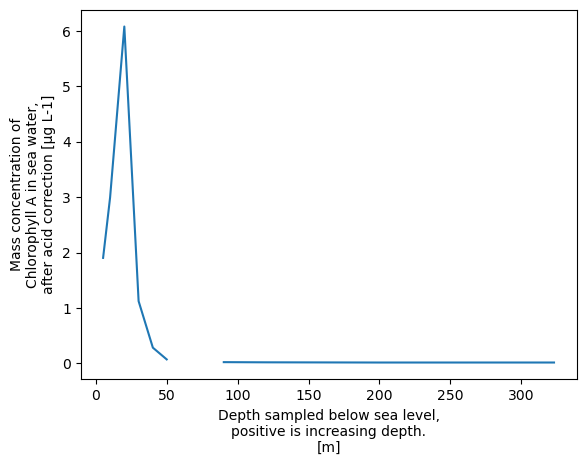
That doesn’t look nice! if we look at the values we can see what is happening.
xrds['CHLOROPHYLL_A_TOTAL'].values
array([0.01565072, 0.01550788, 0.01912119, 0.02236113, nan,
0.07194841, 0.28370929, 1.12279562, 6.07793473, 2.99329871,
1.90354194])
Then let’s drop the nan values before we plot the data.
xr.plot.line(xrds['CHLOROPHYLL_A_TOTAL'].dropna('DEPTH'))
[<matplotlib.lines.Line2D at 0x758e75f17d10>]
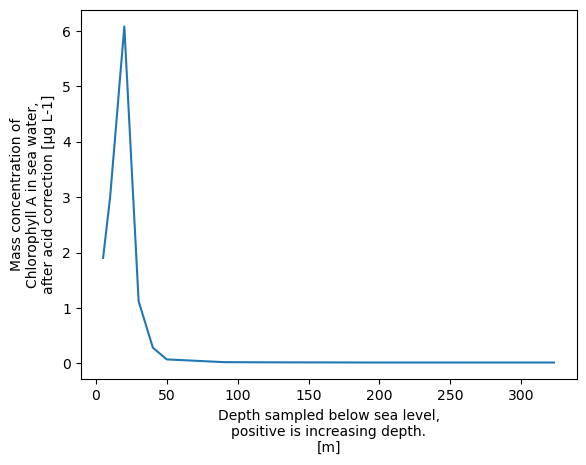
It makes more sense to have depth on the y axis, so let’s do that
xr.plot.line(xrds['CHLOROPHYLL_A_TOTAL'].dropna('DEPTH'),y='DEPTH', yincrease=False)
[<matplotlib.lines.Line2D at 0x758e75f9f150>]
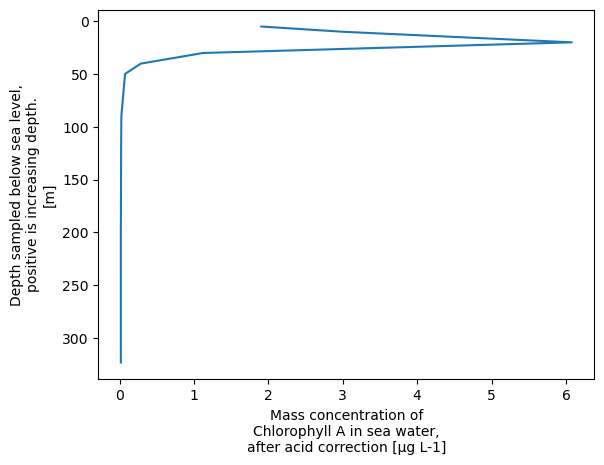
Altneratively, we can easily create a scatter plot
xrds['CHLOROPHYLL_A_TOTAL'].plot.scatter()
<matplotlib.collections.PathCollection at 0x758e76a11250>
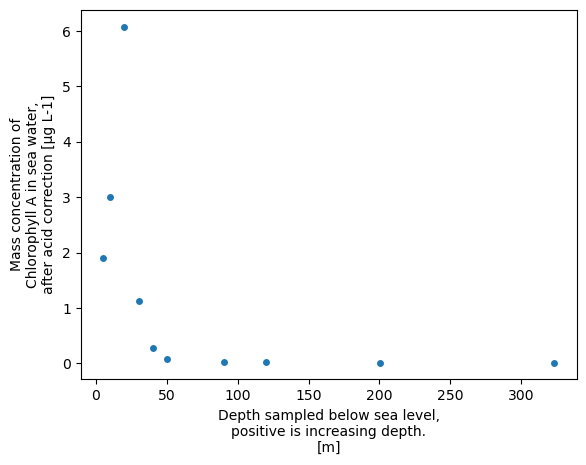
xrds.plot.scatter(x='CHLOROPHYLL_A_TOTAL', y='DEPTH', yincrease=False)
<matplotlib.collections.PathCollection at 0x758e76a91390>
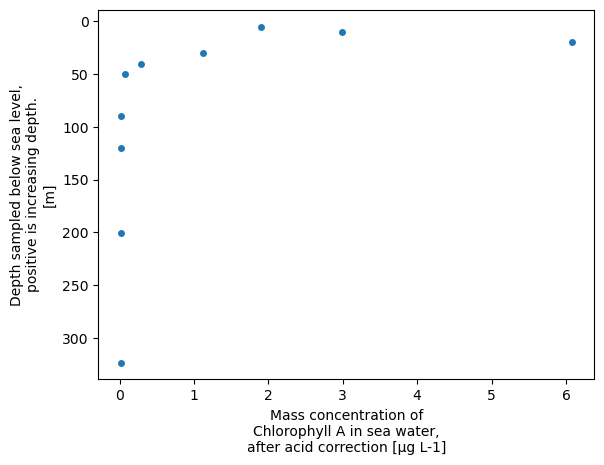
Let’s try some alternative plots
# Histogram
xrds['CHLOROPHYLL_A_TOTAL'].plot.hist()
(array([6., 1., 0., 1., 1., 0., 0., 0., 0., 1.]),
array([0.01550788, 0.62175057, 1.22799325, 1.83423594, 2.44047862,
3.04672131, 3.65296399, 4.25920668, 4.86544936, 5.47169204,
6.07793473]),
<BarContainer object of 10 artists>)
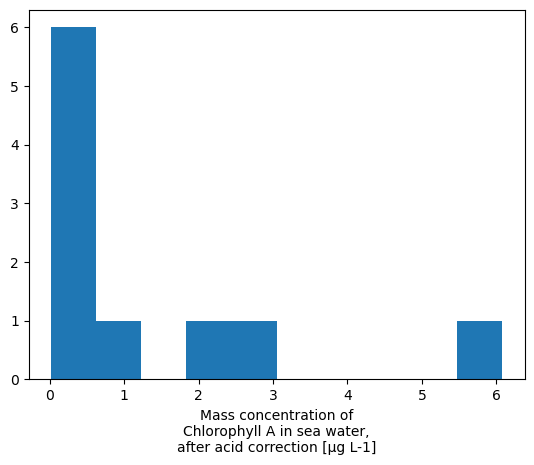
# Step plot
xrds['CHLOROPHYLL_A_TOTAL'].plot.step()
[<matplotlib.lines.Line2D at 0x758e76a87d10>]
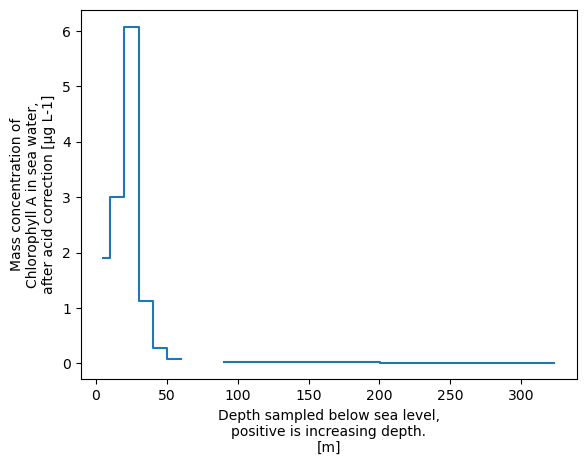
We can also plot multiple variables together
xrds['CHLOROPHYLL_A_TOTAL'].plot.line(y='DEPTH', yincrease=False, label='TOTAL')
xrds['CHLOROPHYLL_A_10um'].plot.line(y='DEPTH', yincrease=False, label='10um')
[<matplotlib.lines.Line2D at 0x758e804a9a10>]
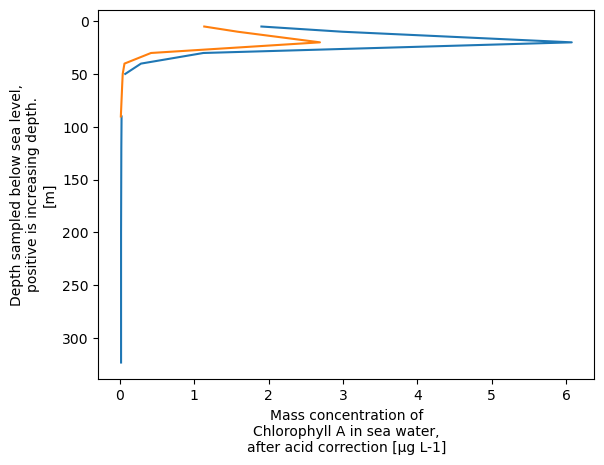
But if we actually want to see the labels, we need to use the matplotlib library
import matplotlib.pyplot as plt
xrds['CHLOROPHYLL_A_TOTAL'].plot.line(y='DEPTH', yincrease=False, label='TOTAL')
xrds['CHLOROPHYLL_A_10um'].plot.line(y='DEPTH', yincrease=False, label='10um')
plt.legend()
plt.show()
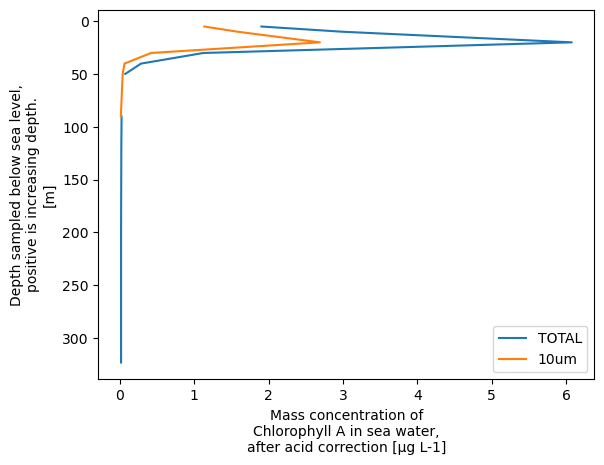
We can now do all kinds of things to customise this plot using the full matplotlib library. For example:
# Set up the figure and subplots
fig, axes = plt.subplots(nrows=1, ncols=2, figsize=(12, 6))
xrds['CHLOROPHYLL_A_TOTAL'].plot.line(y='DEPTH', yincrease=False, label='TOTAL', ax=axes[0])
xrds['CHLOROPHYLL_A_10um'].plot.line(y='DEPTH', yincrease=False, label='10um', ax=axes[0])
axes[0].set_title('Chlorophyll a')
axes[0].legend()
xrds['PHAEOPIGMENTS_TOTAL'].plot.line(y='DEPTH', yincrease=False, label='TOTAL', ax=axes[1])
xrds['PHAEOPIGMENTS_10um'].plot.line(y='DEPTH', yincrease=False, label='10um', ax=axes[1])
axes[1].set_title('Phaeopigments')
axes[1].legend()
# Adjust layout and display the plot
plt.suptitle('Chlorophyll and Phaeopigments')
plt.tight_layout(rect=[0, 0, 1, 0.96]) # Adjust the layout to avoid overlap
plt.show()
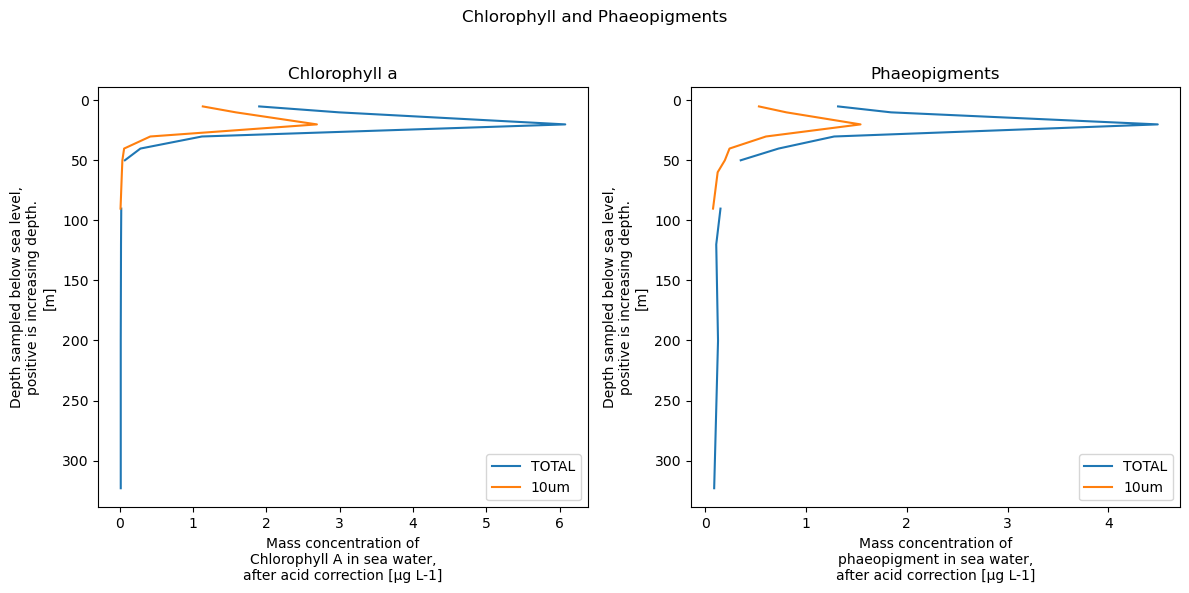
2D plots - e.g. maps#
We will load in some multidimensional data now. This is a dataset of global surface temperature anomalies from the NOAA Global Surface Temperature Dataset (NOAAGlobalTemp), Version 5.0.
https://www.ncei.noaa.gov/access/metadata/landing-page/bin/iso?id=gov.noaa.ncdc:C01585
H.-M. Zhang, B. Huang, J. H. Lawrimore, M. J. Menne, and T. M. Smith (2019): NOAA Global Surface Temperature Dataset (NOAAGlobalTemp), Version 5.0. NOAA National Centers for Environmental Information. doi:10.25921/9qth-2p70 Accessed 2024-01-04.
url = 'https://www.ncei.noaa.gov/thredds/dodsC/noaa-global-temp-v5/NOAAGlobalTemp_v5.0.0_gridded_s188001_e202212_c20230108T133308.nc'
xrds = xr.open_dataset(url)
xrds
<xarray.Dataset>
Dimensions: (time: 1716, lat: 36, lon: 72, z: 1)
Coordinates:
* time (time) datetime64[ns] 1880-01-01 1880-02-01 ... 2022-12-01
* lat (lat) float32 -87.5 -82.5 -77.5 -72.5 -67.5 ... 72.5 77.5 82.5 87.5
* lon (lon) float32 2.5 7.5 12.5 17.5 22.5 ... 342.5 347.5 352.5 357.5
* z (z) float32 0.0
Data variables:
anom (time, z, lat, lon) float32 ...
Attributes: (12/66)
Conventions: CF-1.6, ACDD-1.3
title: NOAA Merged Land Ocean Global Surface Te...
summary: NOAAGlobalTemp is a merged land-ocean su...
institution: DOC/NOAA/NESDIS/National Centers for Env...
id: gov.noaa.ncdc:C00934
naming_authority: gov.noaa.ncei
... ...
time_coverage_duration: P143Y0M
references: Vose, R. S., et al., 2012: NOAAs merged ...
climatology: Climatology is based on 1971-2000 monthl...
acknowledgment: The NOAA Global Surface Temperature Data...
date_modified: 2023-01-08T18:33:09Z
date_issued: 2023-01-08T18:33:09ZThe anom variable has 4 dimensions. We firstly want to access data from a single timeslice (one day).
desired_date = '2022-10-01'
data_for_desired_date = xrds.sel(time=desired_date)
data_for_desired_date
<xarray.Dataset>
Dimensions: (lat: 36, lon: 72, z: 1)
Coordinates:
time datetime64[ns] 2022-10-01
* lat (lat) float32 -87.5 -82.5 -77.5 -72.5 -67.5 ... 72.5 77.5 82.5 87.5
* lon (lon) float32 2.5 7.5 12.5 17.5 22.5 ... 342.5 347.5 352.5 357.5
* z (z) float32 0.0
Data variables:
anom (z, lat, lon) float32 ...
Attributes: (12/66)
Conventions: CF-1.6, ACDD-1.3
title: NOAA Merged Land Ocean Global Surface Te...
summary: NOAAGlobalTemp is a merged land-ocean su...
institution: DOC/NOAA/NESDIS/National Centers for Env...
id: gov.noaa.ncdc:C00934
naming_authority: gov.noaa.ncei
... ...
time_coverage_duration: P143Y0M
references: Vose, R. S., et al., 2012: NOAAs merged ...
climatology: Climatology is based on 1971-2000 monthl...
acknowledgment: The NOAA Global Surface Temperature Data...
date_modified: 2023-01-08T18:33:09Z
date_issued: 2023-01-08T18:33:09ZLet’s plot the data!
data_for_desired_date['anom'].plot()
<matplotlib.collections.QuadMesh at 0x758e75d193d0>
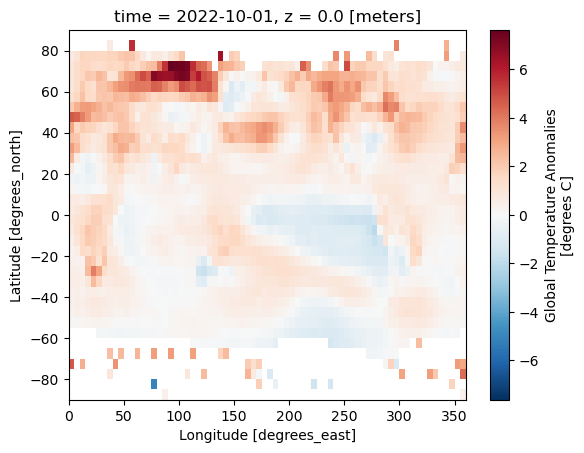
Without the coastlines this is difficult to interpret. We can use the cartopy to help use here.
import cartopy.crs as ccrs
plt.figure(figsize=(10, 5))
ax = plt.axes(projection=ccrs.PlateCarree())
data_for_desired_date['anom'].plot(ax=ax,transform=ccrs.PlateCarree())
ax.coastlines()
plt.title(f'Global Surface Temperature Anomalies for {desired_date}')
ax.set_xticks(range(-180, 181, 60), crs=ccrs.PlateCarree())
ax.set_yticks(range(-90, 91, 30), crs=ccrs.PlateCarree())
ax.set_xlabel('Longitude')
ax.set_ylabel('Latitude')
plt.savefig('../data/media/temperature_anomalies.png')
plt.show()
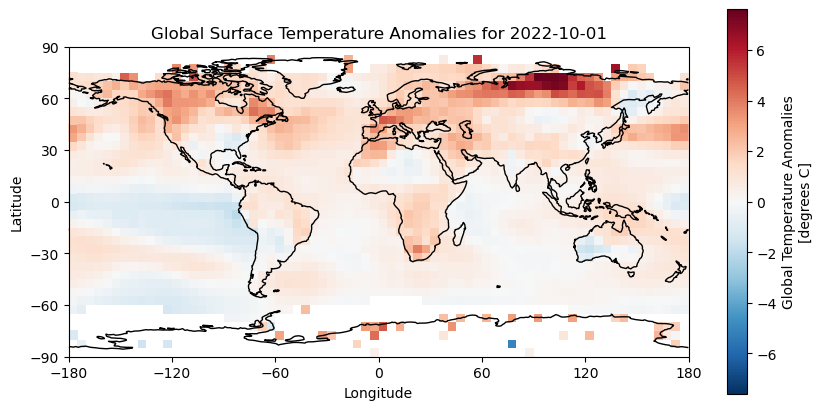
This is designed only to be a short demonstration of how easy it can be to plot data out of a CF-NetCDF file. Matplotlib is very powerful and flexible, and you can use it to create all sorts of plots! There are many good tutorials on how to use matplotlib online, so go and explore!
How to cite this course#
If you think this course contributed to the work you are doing, consider citing it in your list of references. Here is a recommended citation:
Marsden, L. (2024, April 19). NetCDF in Python - from beginner to pro. Zenodo. https://doi.org/10.5281/zenodo.10997447
And you can navigate to the publication and export the citation in different styles and formats by clicking the icon below.
